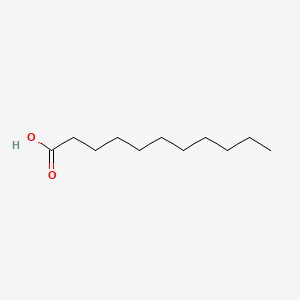| MeSH term | MeSH ID | Detail |
|---|---|---|
| Hemolysis | D006461 | 131 associated lipids |
| Alopecia | D000505 | 14 associated lipids |
UNDECANOIC ACID
UNDECANOIC ACID is a lipid of Fatty Acyls (FA) class. The involved functions are known as Anabolism, Mitosis, Transcriptional Activation, Mismatch Repair and Transcription, Genetic. Undecanoic acid often locates in Protoplasm and spindle microtubule. The associated genes with UNDECANOIC ACID are TERT gene. The related lipids are Fatty Acids and undecanoic acid.
Cross Reference
Introduction
To understand associated biological information of UNDECANOIC ACID, we collected biological information of abnormalities, associated pathways, cellular/molecular locations, biological functions, related genes/proteins, lipids and common seen animal/experimental models with organized paragraphs from literatures.
What diseases are associated with UNDECANOIC ACID?
There are no associated biomedical information in the current reference collection.
Possible diseases from mapped MeSH terms on references
We collected disease MeSH terms mapped to the references associated with UNDECANOIC ACID
PubChem Associated disorders and diseases
What pathways are associated with UNDECANOIC ACID
There are no associated biomedical information in the current reference collection.
PubChem Biomolecular Interactions and Pathways
Link to PubChem Biomolecular Interactions and PathwaysWhat cellular locations are associated with UNDECANOIC ACID?
Visualization in cellular structure
Associated locations are in red color. Not associated locations are in black.
Related references are published most in these journals:
| Location | Cross reference | Weighted score | Related literatures |
|---|
What functions are associated with UNDECANOIC ACID?
Related references are published most in these journals:
| Function | Cross reference | Weighted score | Related literatures |
|---|
What lipids are associated with UNDECANOIC ACID?
Related references are published most in these journals:
| Lipid concept | Cross reference | Weighted score | Related literatures |
|---|
What genes are associated with UNDECANOIC ACID?
Related references are published most in these journals:
| Gene | Cross reference | Weighted score | Related literatures |
|---|
What common seen animal models are associated with UNDECANOIC ACID?
There are no associated biomedical information in the current reference collection.
NCBI Entrez Crosslinks
All references with UNDECANOIC ACID
Download all related citations| Authors | Title | Published | Journal | PubMed Link |
|---|---|---|---|---|
| Encarnação JM et al. | Piezoelectric biosensors assisted with electroacoustic impedance spectroscopy: a tool for accurate quantitative molecular recognition analysis. | 2009 Mar-Apr | J. Mol. Recognit. | pmid:18680206 |
| Pozo OJ et al. | Quantification of testosterone undecanoate in human hair by liquid chromatography-tandem mass spectrometry. | 2009 | Biomed. Chromatogr. | pmid:19353724 |
| Fontana A et al. | The effects of arbuscular mycorrhizal fungi on direct and indirect defense metabolites of Plantago lanceolata L. | 2009 | J. Chem. Ecol. | pmid:19568812 |
| Pesek JJ et al. | Aqueous normal-phase retention of nucleotides on silica hydride columns. | 2009 | J Chromatogr A | pmid:19135674 |
| Shen XW et al. | Production and characterization of homopolymer poly(3-hydroxyvalerate) (PHV) accumulated by wild type and recombinant Aeromonas hydrophila strain 4AK4. | 2009 | Bioresour. Technol. | pmid:19395256 |
| De Lisi R et al. | Thermodynamics of surfactants, block copolymers and their mixtures in water: the role of the isothermal calorimetry. | 2009 | Int J Mol Sci | pmid:19742173 |
| Abel C et al. | Floral and insect-induced volatile formation in Arabidopsis lyrata ssp. petraea, a perennial, outcrossing relative of A. thaliana. | 2009 | Planta | pmid:19322583 |
| Staab CA et al. | Medium-chain fatty acids and glutathione derivatives as inhibitors of S-nitrosoglutathione reduction mediated by alcohol dehydrogenase 3. | 2009 | Chem. Biol. Interact. | pmid:19428350 |
| Kigathi RN et al. | Emission of volatile organic compounds after herbivory from Trifolium pratense (L.) under laboratory and field conditions. | 2009 | J. Chem. Ecol. | pmid:20013039 |
| Ammendola S et al. | 10-undecanhydroxamic acid, a hydroxamate derivative of the undecanoic acid, has strong antimicrobial activity through a mechanism that limits iron availability. | 2009 | FEMS Microbiol. Lett. | pmid:19493009 |
